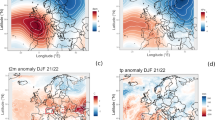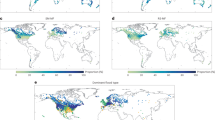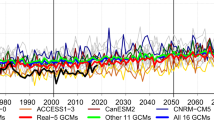Abstract
Destructive and costly flooding can occur when warm storm systems deposit substantial rain on extensive snowcover1,2,3,4,5,6, as observed in February 2017 with the Oroville Dam crisis in California7. However, decision-makers lack guidance on how such rain-on-snow (ROS) flood risk may respond to climate change. Here, daily ROS events with flood-generating potential8 are simulated over western North America for a historical (2000–2013) and future (forced under Representative Concentration Pathway 8.59) period with the Weather Research and Forecasting model; 4 km resolution allows the basin-scale ROS flood risk to be assessed. In the warmer climate, we show that ROS becomes less frequent at lower elevations due to snowpack declines, particularly in warmer areas (for example, the Pacific maritime region). By contrast, at higher elevations where seasonal snowcover persists, ROS becomes more frequent due to a shift from snowfall to rain. Accordingly, the water available for runoff10 increases for 55% of western North American river basins, with corresponding increases in flood risk of 20–200%, the greatest changes of which are projected for the Sierra Nevada, the Colorado River headwaters and the Canadian Rocky Mountains. Thus, flood control and water resource planning must consider ROS to fully quantify changes in flood risk with anthropogenic warming.
This is a preview of subscription content, access via your institution
Access options
Access Nature and 54 other Nature Portfolio journals
Get Nature+, our best-value online-access subscription
$29.99 / 30 days
cancel any time
Subscribe to this journal
Receive 12 print issues and online access
$209.00 per year
only $17.42 per issue
Buy this article
- Purchase on Springer Link
- Instant access to full article PDF
Prices may be subject to local taxes which are calculated during checkout




Similar content being viewed by others
References
Kattelmann, R. Flooding from rain-on-snow events in the Sierra Nevada. IAHS Publ. Ser. Proc. Rep. Intern Assoc. Hydrol. Sci. 239, 59–66 (1997).
Marks, D., Kimball, J., Tingey, D. & Link, T. The sensitivity of snowmelt processes to climate conditions and forest cover during rain-on-snow: a case study of the 1996 Pacific Northwest flood. Hydrol. Process. 12, 1569–1587 (1998).
McCabe, G. J., Hay, L. E. & Clark, M. P. Rain-on-snow events in the western United States. Bull. Am. Meteorol. Soc. 88, 319–328 (2007).
Berghuijs, W. R., Woods, R. A., Hutton, C. J. & Sivapalan, M. Dominant flood generating mechanisms across the United States. Geophys. Res. Lett. 43, 4382–4390 (2016).
Merz, R. & Blöschl, G. A process typology of regional floods. Water Resour. Res. 39, 1340 (2003).
Pomeroy, J. W., Stewart, R. E. & Whitfield, P. H. The 2013 flood event in the South Saskatchewan and Elk River basins: causes, assessment and damages. Can. Water Resour. J. 41, 105–117 (2016).
Vahedifard, F., AghaKouchak, A., Ragno, E., Shahrokhabadi, S. & Mallakpour, I. Lessons from the Oroville dam. Science 355, 1139–1140 (2017).
Freudiger, D., Kohn, I., Stahl, K. & Weiler, M. Large-scale analysis of changing frequencies of rain-on-snow events with flood-generation potential. Hydrol. Earth Syst. Sci. 18, 2695 (2014).
Riahi, K. et al. RCP 8.5—a scenario of comparatively high greenhouse gas emissions. Climatic Change 109, 33–57 (2011).
Mazurkiewicz, A. B., Callery, D. G. & McDonnell, J. J. Assessing the controls of the snow energy balance and water available for runoff in a rain-on-snow environment. J. Hydrol. 354, 1–14 (2008).
Li, D., Wrzesien, M. L., Durand, M., Adam, J. & Letternmaier, D. P. How much runoff originates as snow in the western United States, and how will that change in the future?. Geophys. Res. Lett. 44, 6163–6172 (2017).
Sturm, M., Goldstein, M. A. & Parr, C. Water and life from snow: a trillion dollar science question. Water Resour. Res. 53, 3534–3544 (2017).
Eiriksson, D. et al. An evaluation of the hydrologic relevance of lateral flow in snow at hillslope and catchment scales. Hydrol. Process. 27, 640–654 (2013).
Singh, P., Spitzbart, G., Hübl, H. & Weinmeister, H. Hydrological response of snowpack under rain-on-snow events: a field study. J. Hydrol. 202, 1–20 (1997).
Jeong, D. I. & Sushama, L. Rain-on-snow events over North America based on two Canadian regional climate models. Clim. Dynam. 50, 303–316 (2018).
Barnett, T. P., Adam, J. C. & Lettenmaier, D. P. Potential impacts of a warming climate on water availability in snow-dominated regions. Nature 438, 303–309 (2005).
Arnell, N. W. & Gosling, S. N. The impacts of climate change on river flood risk at the global scale. Climatic Change 134, 387–401 (2016).
Hirabayashi, Y. et al. Global flood risk underclimate change. Nat. Clim. Change 3, 816–821 (2013).
Prein, A. F. et al. Importance of regional climate model grid spacing for the simulation of heavy precipitation in the Colorado headwaters. J. Clim. 26, 4848–4857 (2013).
Ikeda, K. et al. Simulation of seasonal snowfall over Colorado. Atmos. Res. 97, 462–477 (2010).
Wayand, N. E., Lundquist, J. D. & Clark, M. P. Modeling the influence of hypsometry, vegetation, and storm energy on snowmelt contributions to basins during rain‐on‐snow floods. Water Resour. Res. 51, 8551–8569 (2015).
Jennings, K. & Jones, J. A. Precipitation‐snowmelt timing and snowmelt augmentation of large peak flow events, western Cascades, Oregon. Water Resour. Res. 51, 7649–7661 (2015).
Musselman, K. N., Molotch, N. P., & Margulis, S. A.. Snowmelt response to simulated warming across a large elevation gradient, southern Sierra Nevada, California. Cryosphere 11, 2847–2866 (2017).
Liu, C. et al. Continental-scale convection-permitting modeling of the current and future climate of North America. Clim. Dynam. 49, 71–95 (2017).
Mote, P. W., Hamlet, A. F., Clark, M. P. & Lettenmaier, D. Declining mountain snowpack in western North America. Bull. Am. Meteorol. Soc. 86, 39–49 (2005).
Knowles, N., Dettinger, M. D. & Cayan, D. R. Trends in snowfall versus rainfall in the Western United States. J. Clim. 19, 4545–4559 (2006).
Trenberth, K. E. Changes in precipitation with climate change. Clim. Res. 47, 123–138 (2011).
Trujillo, E. & Molotch, N. P. Snowpack regimes of the Western United States. Water Resour. Res. 50, 5611–5623 (2014).
Rasmussen, R. et al. High-resolution coupled climate runoff simulations of seasonal snowfall over Colorado: a process study of current and warmer climate. J. Clim. 24, 3015–3048 (2011).
Hamlet, A. F. & Lettenmaier, D. P. Effects of 20th century warming and climate variability on flood risk in the western US. Water Resour. Res. 43, W06427 (2007).
Dee, D. et al. The ERA‐Interim reanalysis: configuration and performance of the data assimilation system. Q. J. R. Meteorol. Soc. 137, 553–597 (2011).
Niu, G.-Y. et al. The community Noah land surface model with multiparameterization options (Noah-MP): 1. Model description and evaluation with local-scale measurements. J. Geophys. Res. 116, D12109 (2011).
Jennings, K. S., Winchell, T. S., Livneh, B. & Molotch, N. P. Spatial variation of the rain–snow temperature threshold across the Northern Hemisphere. Nat. Commun. 9, 1148 (2018).
Musselman, K. N., Clark, M. P., Liu, C., Ikeda, K. & Rasmussen, R. Slower snowmelt in a warmer world. Nat. Clim. Change 7, 214–219 (2017).
Prein, A. F. et al. Increased rainfall volume from future convective storms in the US. Nat. Clim. Change 7, 880–884 (2017).
Prein, A. F. et al. The future intensification of hourly precipitation extremes. Nat. Clim. Change 7, 48–52 (2017).
Carroll, T. et al. NOHRSC operations and the simulation of snow cover properties for the coterminous U.S. in Proc. 69th Western Snow Conference 16–19 (Western Snow Conference, 2001).
Musselman, K. N., Pomeroy, J. W., Essery, R. L. & Leroux, N. Impact of windflow calculations on simulations of alpine snow accumulation, redistribution and ablation. Hydrol. Process. 29, 3983–3999 (2015).
Wayand, N. E., Marsh, C. B., Shea, J. M. & Pomeroy, J. W. Globally scalable alpine snow metrics. Remote Sens. Environ. 213, 61–72 (2018).
Daly, C. et al. Physiographically sensitive mapping of climatological temperature and precipitation across the conterminous United States. Int. J. Climatol. 28, 2031–2064 (2008).
Schär, C., Frei, C., Lüthi, D. & Davies, H. C. Surrogate climate‐change scenarios for regional climate models. Geophys. Res. Lett. 23, 669–672 (1996).
Rasmussen, R. et al. Climate change impacts on the water balance of the Colorado headwaters: high-resolution regional climate model simulations. J. Hydrometeorol. 15, 1091–1116 (2014).
Shaw, T. et al. Storm track processes and the opposing influences of climate change. Nat. Geosci. 9, 656–664 (2016).
Pendergrass, A. G., Knutti, R., Lehner, F., Deser, C. & Sanderson, B. M. Precipitation variability increases in a warmer climate. Sci. Rep. 7, 17966 (2017).
Klein Tank, A. M. G., Zwiers, F. W. & Zhang, X. Guidelines on Analysis of Extremes in a Changing Climate in Support of Informed Decisions for Adaptation Report No. 72 (World Climate Data and Monitoring Programme, World Meteorological Organization, 2009).
Würzer, S., Jonas, T., Wever, N. & Lehning, M. Influence of initial snowpack properties on runoff formation during rain-on-snow events. J. Hydrometeorol. 17, 1801–1815 (2016).
Trubilowicz, J. W. & Moore, R. Quantifying the role of the snowpack in generating water available for runoff during rain‐on‐snow events from snow pillow records. Hydrolog. Process. 31, 4136–4150 (2017).
Acknowledgements
The National Center for Atmospheric Research (NCAR) is sponsored by the National Science Foundation (NSF). K.N.M. was supported under an NCAR Advanced Study Program (ASP) Postdoctoral Fellowship. F.L. was supported by a Postdoc Applying Climate Expertise (PACE) fellowship co-sponsored by the National Oceanic and Atmospheric Administration and the Bureau of Reclamation, administered by Cooperative Programs for the Advancement of Earth System Science (CPAESS). The authors acknowledge high-performance computing support from Yellowstone (ark:/85065/d7wd3xhc) provided by NCAR’s Computational and Information Systems Laboratory, sponsored by the NSF. The authors also thank N. Mizukami, A. Newman and E. Gutmann for discussions.
Author information
Authors and Affiliations
Contributions
All authors designed the study. K.N.M. conducted the analysis. C.L. ran the WRF simulations. K.I. managed the WRF output. M.B. customized the WRF output that facilitated ROS analysis. K.N.M., F.L., A.F.P. and M.P.C. contributed to the interpretations of the results. K.N.M., F.L., A.F.P., M.P.C. and R.R. wrote the paper.
Corresponding author
Ethics declarations
Competing interests
The authors declare no competing interests.
Additional information
Publisher’s note: Springer Nature remains neutral with regard to jurisdictional claims in published maps and institutional affiliations.
Supplementary information
Supplementary Information Description: Supplementary Figures 1–7
Supplementary Figures 1–7
Rights and permissions
About this article
Cite this article
Musselman, K.N., Lehner, F., Ikeda, K. et al. Projected increases and shifts in rain-on-snow flood risk over western North America. Nature Clim Change 8, 808–812 (2018). https://doi.org/10.1038/s41558-018-0236-4
Received:
Accepted:
Published:
Issue Date:
DOI: https://doi.org/10.1038/s41558-018-0236-4
This article is cited by
-
Imprint of urbanization on snow precipitation over the continental USA
Nature Communications (2024)
-
Climate-resilience of dams and levees in Canada: a review
Discover Applied Sciences (2024)
-
Hydrometeorological analysis of July-2023 floods in Himachal Pradesh, India
Natural Hazards (2024)
-
An autoencoder-based snow drought index
Scientific Reports (2023)
-
High-elevation snowpack loss during the 2021 Pacific Northwest heat dome amplified by successive spring heatwaves
npj Climate and Atmospheric Science (2023)



